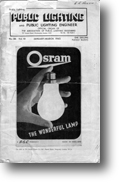 |
the coming of age of the association of public lighting engineers
Published in: Public Lighting Engineer No. 36, Vol. 10, January-March 1945

Haydn T. Harrison
Lt-Commander, R.V.N.R., M.I.E.E
The coming of age of the Association of Public Lighting Engineers and the good work they have carried out
during the last twenty-one years prompts me to write a letter of congratulation.
I am in a good position to be able to judge the progress in street lighting, as it is now fifty years
since I concentrated my attention on this special branch of lighting, after studying Mr. A. P. Trotter's paper
on Distribution and Measurement of Illumination read before the Institution of Civil Engineers in 1892,
in which street lighting was dealt with from a scientific point of view, and which still remains the
basis on which measurements, contour curves, and, comparisons are made.
In papers read by me before the Institution or Electrical Engineers in 1910, and the Municipal Association in 1925,
I emphasised the higher efficiency, more even illumination, and lower cost, which results from closer spacing and
increasing the height of street light sources. It is gratifying to note that the Ministry of Transport have
also emphasised these important factors in their Report (August, 1937). It is to be hoped that they will facilitate
the adoption of their recommendation; but it is unfortunate that they recommend the siting of posts or standards
on the kerb where they cause so many accidents, and are a danger to the public. If they were sited on the outside of the
route many accidents would be avoided, the columns could be of lighter construction and less conspicuous; moreover,
the use of overhanging brackets could be avoided, as even road illumination would be obtained by using correctly
designed directive reflectors, and the light sources would be further removed from the line of sight of vehicle drivers.
I do not consider the time has arrived to say anything definite about the likely development of suitable
discharge or fluorescent electric lamps, as they cannot be considered to have reached the stage when they
could be wisely adopted on a large scale for street lighting. The public, too, have not had sufficient
opportunity of judging and expressing their opinion of the latest fluorescent type. Public lighting
engineers will also require to consider how the correct light distribution can be obtained.
All these considerations foreshadow a busy time for the Members of the Association of Public Lighting Engineers.
|



